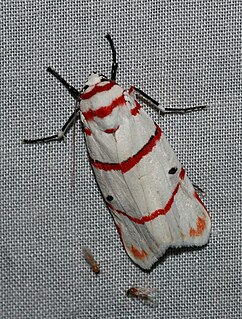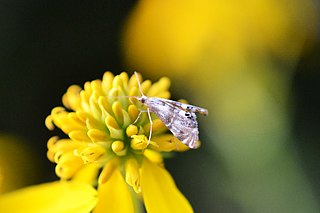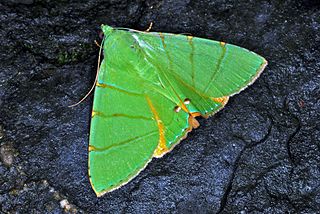Related Research Articles

The Sesiidae or clearwing moths are a diurnal moth family in the order Lepidoptera known for their Batesian mimicry in both appearance and behaviour of various Hymenoptera.

Omiodes is a moth genus in the family Crambidae. Several species are endemic to Hawaii.

Amata is a genus of tiger moths in the family Erebidae. The genus was erected by Johan Christian Fabricius in 1807.

Cisthene is a genus of lichen moths in the family Erebidae. The genus was erected by Francis Walker in 1854.

Cyana is a genus of moths in the family Erebidae. Species are well distributed in Africa, Madagascar, China, India, Sri Lanka, Myanmar, Sumatra, Java and Borneo. The genus was erected by Francis Walker in 1854.

Macaduma is a genus of moths in the subfamily Arctiinae.

Halone coryphoea is a moth of the subfamily Arctiinae first described by George Hampson in 1914. It is found in Australia.

Halone sejuncta, the variable halone, is a moth of the subfamily Arctiinae first described by Rudolf Felder and Alois Friedrich Rogenhofer in 1875. It is found in Australia in Queensland, New South Wales, the Australian Capital Territory, Victoria, Tasmania and South Australia.
Siccia is a genus of moths in the family Erebidae. The genus was erected by Francis Walker in 1854.

Spilosoma is a genus of moths in the family Erebidae originally described by John Curtis in 1825. A very heterogeneous group, it is in need of review by the scientific community, as certain species probably need reclassification into their own genera.

Aulacodes is a genus of moths of the family Crambidae. The genus was first described by Achille Guenée in 1854.

Petrophila is a genus of moths of the family Crambidae. The genus was described by Lansdown Guilding in 1830.

Eulepidotis is a genus of moths of the family Erebidae erected by Jacob Hübner in 1823.

Aphomia is a genus of small moths belonging to the family Pyralidae. Some breed in the nests of Anthophila, where their caterpillars are parasitic feeders of wax, honey and pollen.

Halone pteridaula, the brown halone, is a species of moth of the subfamily Arctiinae first described by Turner in 1922. It is known from the Australian Capital Territory, New South Wales, Queensland, Tasmania and Victoria, all in Australia.

Halone prosenes, the pied halone, is a moth of the subfamily Arctiinae first described by Turner in 1940. It is known from the Australian state of Victoria, where it is restricted to the South East Coastal Plain, South Eastern Highlands and the Victorian Volcanic Plain.

The Chrysauginae are a subfamily of snout moths. They are primarily Neotropical and include about 400 described species.
Halone ophiodes, the cryptic halone, is a moth of the subfamily Arctiinae. It was described by Edward Meyrick in 1886. It is found in Australia.
Halone flavescens is a moth of the subfamily Arctiinae. It was described by George Hampson in 1898. It is known from Assam, India.
References
- ↑ Savela, Markku. "Halone ebaea Hampson, 1914". Lepidoptera and Some Other Life Forms. Retrieved October 27, 2018.
- Pitkin, Brian & Jenkins, Paul. "Search results Family: Arctiidae". Butterflies and Moths of the World. London: Natural History Museum.
| This Lithosiini-related article is a stub. You can help Wikipedia by expanding it. |